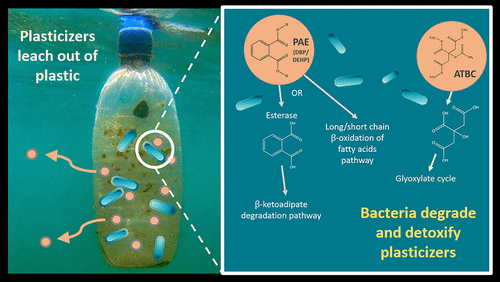当前位置:
X-MOL 学术
›
Environ. Sci. Technol.
›
论文详情
Our official English website, www.x-mol.net, welcomes your
feedback! (Note: you will need to create a separate account there.)
Plasticizer Degradation by Marine Bacterial Isolates: A Proteogenomic and Metabolomic Characterization.
Environmental Science & Technology ( IF 10.8 ) Pub Date : 2020-01-14 , DOI: 10.1021/acs.est.9b05228 Robyn J Wright 1, 2 , Rafael Bosch 3, 4 , Matthew I Gibson 5, 6 , Joseph A Christie-Oleza 1, 3, 4
Environmental Science & Technology ( IF 10.8 ) Pub Date : 2020-01-14 , DOI: 10.1021/acs.est.9b05228 Robyn J Wright 1, 2 , Rafael Bosch 3, 4 , Matthew I Gibson 5, 6 , Joseph A Christie-Oleza 1, 3, 4
Affiliation

|
Many commercial plasticizers are toxic endocrine-disrupting chemicals that are added to plastics during manufacturing and may leach out once they reach the environment. Traditional phthalic acid ester plasticizers (PAEs), such as dibutyl phthalate (DBP) and bis(2-ethyl hexyl) phthalate (DEHP), are now increasingly being replaced with more environmentally friendly alternatives, such as acetyl tributyl citrate (ATBC). While the metabolic pathways for PAE degradation have been established in the terrestrial environment, to our knowledge, the mechanisms for ATBC biodegradation have not been identified previously and plasticizer degradation in the marine environment remains underexplored. From marine plastic debris, we enriched and isolated microbes able to grow using a range of plasticizers and, for the first time, identified the pathways used by two phylogenetically distinct bacteria to degrade three different plasticizers (i.e., DBP, DEHP, and ATBC) via a comprehensive proteogenomic and metabolomic approach. This integrated multi-OMIC study also revealed the different mechanisms used for ester side-chain removal from the different plasticizers (esterases and enzymes involved in the β-oxidation pathway) as well as the molecular response to deal with toxic intermediates, that is, phthalate, and the lower biodegrading potential detected for ATBC than for PAE plasticizers. This study highlights the metabolic potential that exists in the biofilms that colonize plastics-the Plastisphere-to effectively biodegrade plastic additives and flags the inherent importance of microbes in reducing plastic toxicity in the environment.
中文翻译:

海洋细菌分离物对增塑剂的降解:蛋白质组学和代谢组学表征。
许多商业增塑剂是破坏性内分泌的有毒化学物质,在制造过程中会添加到塑料中,一旦到达环境,它们可能会滤出。传统的邻苯二甲酸酯增塑剂(PAE),例如邻苯二甲酸二丁酯(DBP)和邻苯二甲酸双(2-乙基己基)邻苯二甲酸酯(DEHP),现在正被更环保的替代品替代,例如乙酰基柠檬酸三丁酯(ATBC)。尽管在陆地环境中已经建立了PAE降解的代谢途径,但据我们所知,以前尚未确定ATBC生物降解的机制,并且海洋环境中增塑剂的降解作用仍未得到充分研究。我们从海洋塑料碎片中富集并分离出了能够使用多种增塑剂生长的微生物,这是第一次,通过全面的蛋白质组学和代谢组学方法,鉴定了两种系统发育不同的细菌降解三种不同增塑剂(即DBP,DEHP和ATBC)所使用的途径。这项集成的多OMIC研究还揭示了从不同的增塑剂(酯酶和参与β-氧化途径的酶)去除酯侧链的不同机制,以及处理有毒中间体(即邻苯二甲酸酯)的分子反应,并且与PAE增塑剂相比,ATBC的生物降解潜力更低。这项研究强调了存在于定居在塑料中的生物膜(等离子层)中存在的代谢潜力,以有效地生物降解塑料添加剂,并标明了微生物在降低环境中塑料毒性方面的内在重要性。
更新日期:2020-01-15
中文翻译:

海洋细菌分离物对增塑剂的降解:蛋白质组学和代谢组学表征。
许多商业增塑剂是破坏性内分泌的有毒化学物质,在制造过程中会添加到塑料中,一旦到达环境,它们可能会滤出。传统的邻苯二甲酸酯增塑剂(PAE),例如邻苯二甲酸二丁酯(DBP)和邻苯二甲酸双(2-乙基己基)邻苯二甲酸酯(DEHP),现在正被更环保的替代品替代,例如乙酰基柠檬酸三丁酯(ATBC)。尽管在陆地环境中已经建立了PAE降解的代谢途径,但据我们所知,以前尚未确定ATBC生物降解的机制,并且海洋环境中增塑剂的降解作用仍未得到充分研究。我们从海洋塑料碎片中富集并分离出了能够使用多种增塑剂生长的微生物,这是第一次,通过全面的蛋白质组学和代谢组学方法,鉴定了两种系统发育不同的细菌降解三种不同增塑剂(即DBP,DEHP和ATBC)所使用的途径。这项集成的多OMIC研究还揭示了从不同的增塑剂(酯酶和参与β-氧化途径的酶)去除酯侧链的不同机制,以及处理有毒中间体(即邻苯二甲酸酯)的分子反应,并且与PAE增塑剂相比,ATBC的生物降解潜力更低。这项研究强调了存在于定居在塑料中的生物膜(等离子层)中存在的代谢潜力,以有效地生物降解塑料添加剂,并标明了微生物在降低环境中塑料毒性方面的内在重要性。











































 京公网安备 11010802027423号
京公网安备 11010802027423号